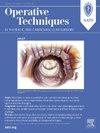Surgical Implantation of Melody Valve in Mitral Position in Infants and Small Children: Toronto SickKids Method
Q3 Medicine
Operative Techniques in Thoracic and Cardiovascular Surgery
Pub Date : 2025-06-01
DOI:10.1053/j.optechstcvs.2024.11.002
引用次数: 0
Abstract
In infants and small children with critical mitral valve disease nonamenable to repair is a high-risk population with high mortality after mechanical mitral valve replacement (MVR). Placement of the Melody™ valve (Medtronic, Minneapolis, MN, USA) in the mitral position has emerged as a palliative surgical strategy that provides time for somatic growth, until mechanical MVR becomes an appropriate option. Advantages of the Melody valve include its excellent early hemodynamics, no necessary extensive anticoagulation, and relative ease of implantation. Valve sizing is determined by preoperative echocardiography and intraoperative Hegar insertion. Toronto Melody valve modification includes a polytetrafluoroethylene skirt for anchoring to the mitral annulus and a large wedge resection of the stent to prevent left ventricular outflow tract obstruction. Once implanted and tied in standard fashion to conventional MVR, serial balloon dilations are performed to ensure that the valve is well expanded along the length of the stent. Left atrial augmentation may be required to ensure the valve is not obstructing pulmonary vein orifices. Our experience suggests that close surveillance for structural valve deterioration is imperative beyond 2-years post-implantation. In summary, the Melody valve is a safe and efficient temporizing strategy for infants requiring MVR.
婴儿和儿童二尖瓣位置的外科植入:多伦多病童方法
不能修复的危重二尖瓣疾病的婴幼儿是机械二尖瓣置换术(MVR)后死亡率高的高危人群。在二尖瓣位置放置Melody™瓣膜(Medtronic, Minneapolis, MN, USA)已成为一种姑息性手术策略,为躯体生长提供时间,直到机械MVR成为合适的选择。梅洛迪瓣膜的优点包括其良好的早期血流动力学,不需要广泛的抗凝,相对容易植入。通过术前超声心动图和术中Hegar插入确定瓣膜大小。多伦多梅洛蒂瓣膜改良包括聚四氟乙烯支架固定在二尖瓣环和大楔形切除支架以防止左心室流出道阻塞。一旦植入并以标准方式捆绑到传统的MVR上,就需要进行一系列球囊扩张,以确保瓣膜沿着支架的长度得到良好的扩张。可能需要左心房增强术以确保瓣膜不阻塞肺静脉口。我们的经验表明,在植入术后2年内密切监测瓣膜结构恶化是必要的。综上所述,梅洛迪瓣膜对于需要MVR的婴儿是一种安全有效的延迟策略。
本文章由计算机程序翻译,如有差异,请以英文原文为准。
求助全文
约1分钟内获得全文
求助全文
来源期刊

Operative Techniques in Thoracic and Cardiovascular Surgery
Medicine-Surgery
CiteScore
1.40
自引率
0.00%
发文量
59
期刊介绍:
Operative Techniques in Thoracic and Cardiovascular Surgery provides richly illustrated articles on techniques in thoracic and cardiovascular surgery written by renowned surgeons. Each issue presents cardiothoracic topics in adult cardiac, congenital, and general thoracic surgery. Each specialty of interest to the thoracic and cardiovascular surgeon is explored through two different approaches to a specific surgical challenge. Each article is thoroughly illustrated with original line drawings, actual intraoperative photos, and supporting tables and graphs.
 求助内容:
求助内容: 应助结果提醒方式:
应助结果提醒方式:


